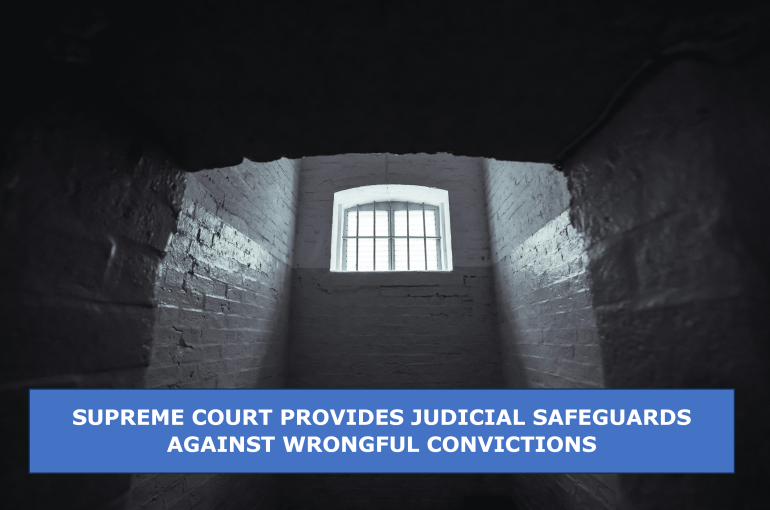SUPREME COURT PROVIDES JUDICIAL SAFEGUARDS AGAINST WRONGFUL CONVICTIONS
A two-Judge Bench of the Supreme Court comprising of Justice Abhay S Oka and Justice Ujjal Bhuyan passed a Judgment dated 29-01-2025 in the matter of Vinobhai vs. State of Kerala, Criminal Appeal No.1730/ 2017 and observed that the conviction must be based on proof beyond a reasonable doubt. The Court held as the available evidence was weak and unreliable, the Appellant was entitled to the benefit of the doubt.
FACTS:
- That the Appeal mentioned above was filed before the Apex Court by one, Vinobhai (Appellant) against the State of Kerala (Respondent), who challenged the decision of the Hon’ble High Court of Kerala (High Court) which, vide, Order dated 07.09.2016, upheld the Order passed by the Ld. Trial Court whereby the Ld. Trial Court passed a sentence for life imprisonment and imposed a penalty of Rs. 1,00,000/-.
- The Appellant, Vinobhai, was convicted under Section 302 of the Indian Penal Code (IPC) for the murder of Ramakrishnan (deceased). On 31.12.2010, at around 11:45 AM, he allegedly stabbed the deceased with a knife, leading to grievous injuries and death.
- There was previous enmity between the Appellant and the deceased. The deceased was allegedly involved in the murder of the Appellant’s elder brother.
- The Ld. Trial Court convicted the Appellant and sentenced him to life imprisonment along with a fine of ₹1,00,000. In default of payment, he was to undergo six months of rigorous imprisonment. The High Court upheld the conviction.
- The Prosecution relied on two eyewitnesses, Shaju (PW-4) and Suresh (PW-5). Their testimonies stated that the Appellant attacked the deceased in front of a shop, stabbing him multiple times. However, another witness, Thressiamma (PW-6), did not support the Prosecution.
- The defense pointed out inconsistencies in the testimonies of PW-4 and PW-5, including material omissions and contradictions. The witnesses were alleged to be chance witnesses, and crucial eyewitnesses were not examined.
TRIAL COURT:
- The Court primarily relied on the depositions of Shaju (PW-4) and Suresh (PW-5), who claimed to have witnessed the attack. PW-4 stated that he saw the Appellant stab the deceased multiple times, and PW-5 supported this version.
- The Court accepted a long-standing enmity between the Appellant and the deceased. The deceased was allegedly involved in the murder of the Appellant’s elder brother, which was considered a strong motive for the crime.
- The Prosecution presented evidence that the murder weapon (knife) and bloodstained clothes were recovered at the instance of the Appellant. The Court accepted this as corroborative evidence.
- The Court acknowledged minor contradictions in the witness testimonies but held that these were not substantial enough to discredit the Prosecution’s case. The omission of certain details in their police statements was not considered significant.
- Based on eyewitness accounts, motive, and recovery of evidence, the Court held that the Appellant’s guilt was established beyond reasonable doubt. It concluded that the Appellant intentionally caused the death of the deceased.
HIGH COURT:
- The High Court accepted the testimonies of Shaju (PW-4) and Suresh (PW-5), considering them reliable. It held that minor contradictions and omissions in their statements were not sufficient to discredit their evidence.
- The High Court agreed with the Trial Court that the previous enmity between the Appellant and the deceased (due to the alleged murder of the Appellant’s brother) established a clear motive.
- The High Court found the recovery of the knife and bloodstained clothes at the instance of the Appellant to be a strong piece of evidence corroborating the Prosecution’s case.
- The Appellant’s counsel pointed out several contradictions in the testimonies of PW-4 and PW-5, such as:
- Their failure to report the incident to the police immediately.
- Their failure to assist the victim or take him to the hospital.
- The absence of crucial eyewitnesses like Sasi and Sumesh.
However, the High Court ruled that these omissions did not shake the Prosecution’s case, since the core event that the Appellant stabbed the deceased—was consistently stated by PW-4 and PW-5.
- The High Court relied on previous Supreme Court judgments to reinforce that minor inconsistencies do not necessarily make eyewitness testimony unreliable. It noted that in criminal cases, full mathematical precision in evidence is not required, as long as the overall case is credible.
ISSUES:
Whether the conviction of the Appellant under Section 302 IPC was justified based on the evidence presented, or whether the Prosecution failed to prove guilt beyond a reasonable doubt.
SUPREME COURT:
The Prosecution relied heavily on the testimonies of Shaju (PW-4) and Suresh (PW-5), but the Court found several inconsistencies and material omissions, making their statements unreliable.
- PW-4 and PW-5 claimed that the Appellant stabbed the deceased 2-3 times on the back, but this detail was not recorded in their initial police statements. PW-4 did not initially state that he was 15 feet away from the crime scene. PW-5’s claim that PW-4 was present at the crime scene was also missing in earlier statements.
- Neither witness reported the crime to the police immediately. No effort was made to take the deceased to a hospital, which the Court found suspicious. PW-4 informed only his nephew (Sumesh), who was not examined as a witness.
- Other potential eyewitnesses, including Sasi from the nearby toddy shop, were not examined by the Prosecution. PW-6, who was expected to support the Prosecution’s case, turned hostile. The High Court relied on the motive (previous enmity due to the murder of the Appellant’s brother), but the Supreme Court clarified that: i) Motive alone is not enough to establish guilt unless supported by credible evidence. ii) Since the eyewitness accounts were unreliable, the motive could not substitute for lack of strong evidence.
- The only remaining evidence was the recovery of the knife and bloodstained clothes at the Appellant’s instance. The Supreme Court, citing Manoj Kumar Soni v. State of M.P. (2023 SCC OnLine SC 984), held that: i) Recovery alone cannot prove guilt unless it is supported by other convincing evidence. ii) A disclosure statement by the accused is not strong enough evidence to convict without corroboration.
- The Supreme Court emphasized that a conviction requires proof beyond a reasonable doubt. Since the only evidence was weak and unreliable, the benefit of the doubt had to go to the Appellant. The Supreme Court quashed the judgments of the Trial Court and High Court.
- The Appellant, having already served 12 years in jail, was acquitted and ordered to be released immediately unless he was required in any other case.
CONCLUSION:
The conviction and sentence imposed by the Trial Court and upheld by the High Court were quashed. The Appellant was acquitted and ordered to be released immediately unless required in another case. This case upholds the law that a person is innocent till proven guilty beyond reasonable doubt.
Sakshi Raghuvanshi
Senior Legal Associate
The Indian Lawyer
Please log on to our YouTube channel The Indian Lawyer Legal Tips and learn about different aspects of the law. Our latest video is on “Law on Ancestral Property” that may be viewed on the link below:





































Leave a Reply